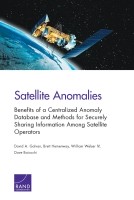| 来源类型 | Research Reports
|
| 规范类型 | 报告
|
| ISBN | 9780833085863
|
| 来源ID | RR-560-DARPA
|
| Satellite Anomalies: Benefits of a Centralized Anomaly Database and Methods for Securely Sharing Information Among Satellite Operators |
| David A. Galvan; Brett Hemenway; William Welser IV; Dave Baiocchi
|
| 发表日期 | 2014
|
| 出版年 | 2014
|
| 页码 | 78
|
| 语种 | 英语
|
| 结论 |
A Centralized Database Poses Great Advantages- A centralized and standardized satellite anomaly database would aid in anomaly investigations, reducing costs and increasing efficiency. It could also contribute to the scientific understanding of real-world impacts of the near-Earth space environment.
- A single centralized database could offer advantages over multiple smaller ones, which tend to be either broadly available but incomplete, or highly detailed but not broadly available.
- Automated "satellite as a sensor" methods for identifying and cataloguing anomalies may also reduce the workload of those investigating satellite anomalies.
There Are Real Obstacles to Creating a Centralized Database - Commercial satellite owners are reluctant to share detailed anomaly information with the broader community, citing potential decreases in consumer confidence as well as exposure of proprietary information.
- While it might be possible for a government agency or third party to build and manage such a centralized and secure database, there is a lack of dedicated resources available to support such a service.
There Are Solutions - Management of a centralized database by a trusted third party, encryption techniques such as secure multiparty computing, and differential privacy may help overcome inhibitions of commercial satellite operators to share anomaly information, thus contributing to greater benefit throughout the satellite operator community.
- Candidate organizations that could serve as a trusted third party include federal agencies and federally funded research and development centers. Satellite insurance companies could also play this role, as they have an interest in maintaining data and in keeping it secret for clients.
|
| 摘要 |
- Additional research into applying the methods discussed to satellite anomaly identification and secure sharing could enable enhanced and efficient anomaly diagnosis by the broader satellite operator community.
- The commercial satellite operator community must be convinced that the sharing mechanism meets their privacy standards and that the benefit of sharing is worth the effort and perceived risk.
- Another positive step would be allotment of resources to government agencies or third-party entities that would be trusted to serve as stewards of the database.
- There is a need for innovative business plans that could enable stewards of existing private databases (such as insurance companies) to facilitate sharing of anomaly information via incentives for clients willing to participate, or aggregated publication of anomaly data that does not reveal identify.
|
| 主题 | Commercial Satellites
; Cyber and Data Sciences
; Cybersecurity
; Databases and Data Collection
; Analysis
; and Processing
|
| URL | https://www.rand.org/pubs/research_reports/RR560.html
|
| 来源智库 | RAND Corporation (United States)
|
| 资源类型 | 智库出版物
|
| 条目标识符 | http://119.78.100.153/handle/2XGU8XDN/107802
|
推荐引用方式
GB/T 7714 |
David A. Galvan,Brett Hemenway,William Welser IV,et al. Satellite Anomalies: Benefits of a Centralized Anomaly Database and Methods for Securely Sharing Information Among Satellite Operators. 2014.
|
|
文件名:
|
x1495316360891.jpg
|
|
格式:
|
JPEG
|

|
文件名:
|
RAND_RR560.pdf
|
|
格式:
|
Adobe PDF
|
除非特别说明,本系统中所有内容都受版权保护,并保留所有权利。